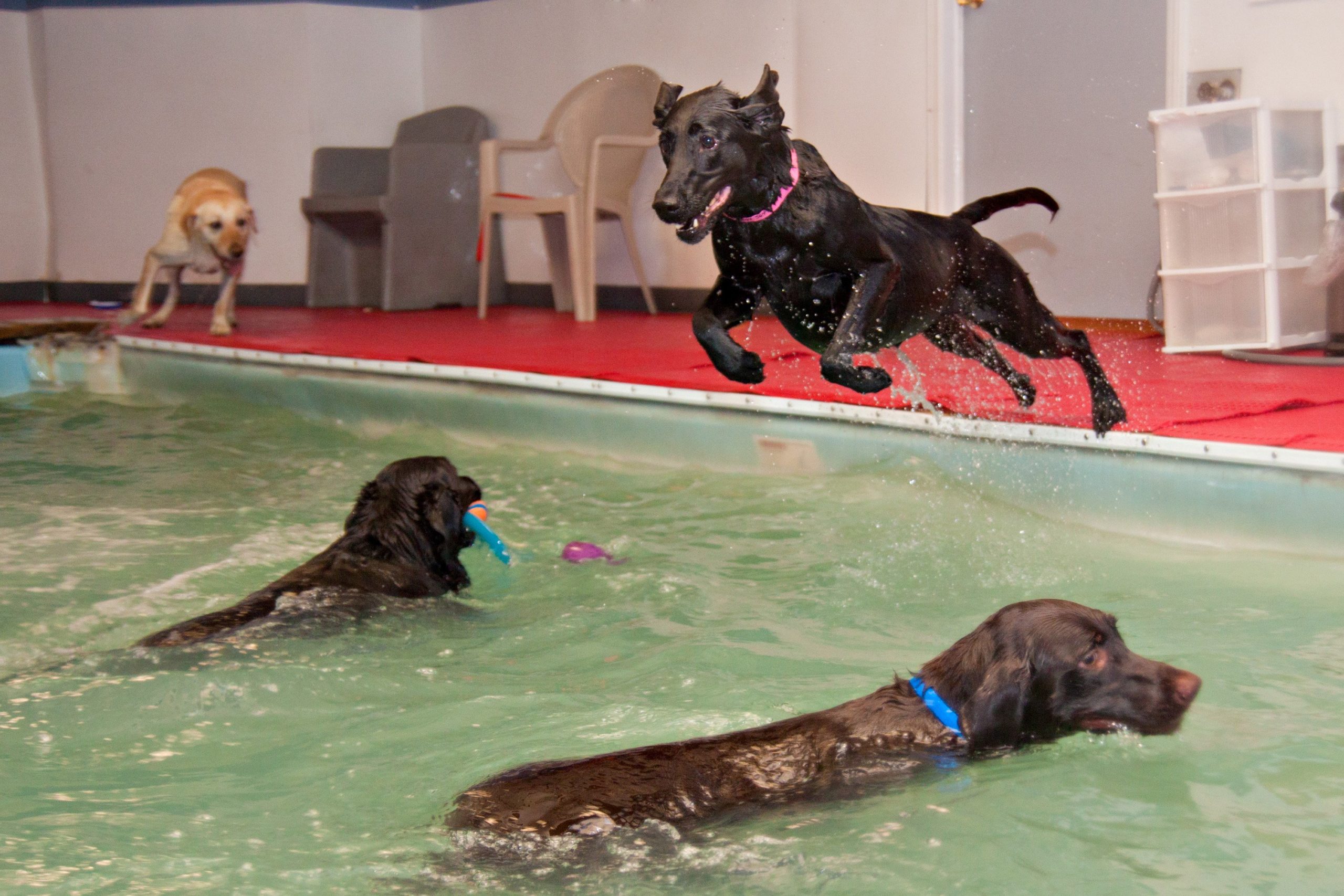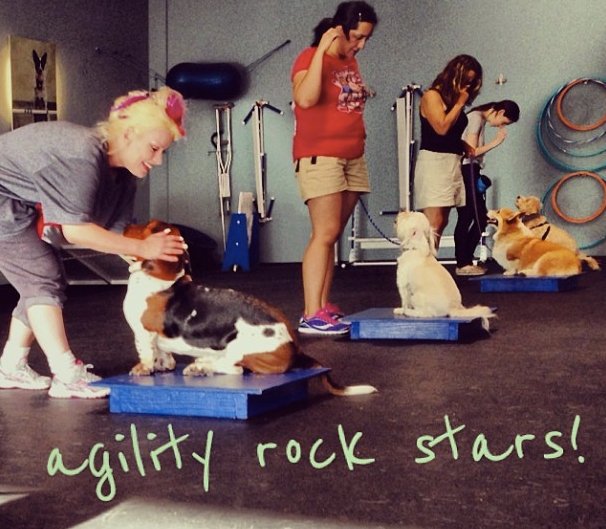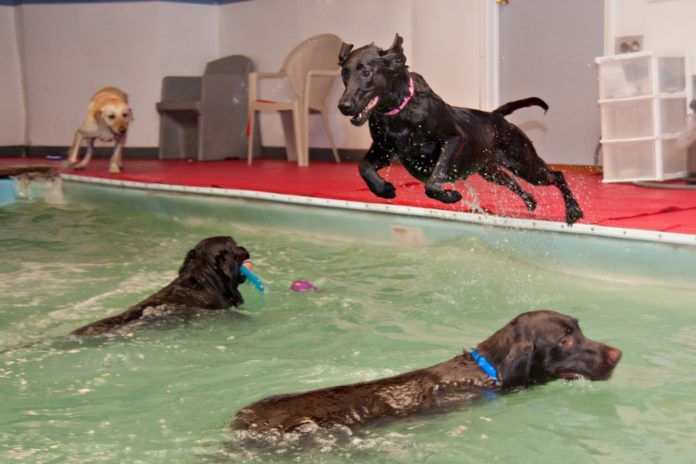As people hunt and gather less and less, they go to gyms more and more. The human body is primed to expend energy, build muscle in its daily work, and stave off ill moods through the release of endorphins triggered by vigorous physical activity. If the body can’t get its fix by lugging a bison through a field back to its family or farming an acre of land, it can simulate the energy needed to procure food in the wild by working out in a clean, well-lighted gym.
Heather’s Paw Prints

It’s the same with dogs. Bred to do jobs—take daring rides with fire fighters to help put out dangerous flames, herd cattle, and lead Alpine rescuers to hobbled hikers—the canine body is supposed to be involved on a regular basis in some muscle-challenging endeavors. But while dogs are bred to work, work has pretty much been bred out of their existence, so to speak. Fortunately, now, more and more, our canine companions, too, can meet their need to use their bodies in exercise facilities. Dog gyms are popping up all over the country—an idea whose time has come, given that a little more than half the dogs in the United States are overweight, according to a report by the Association for Pet Obesity Prevention. Owners invested in providing their dogs with exercise, not to mention social time and perhaps some grooming in the process, can now often find the right fit not too far from their own backyard.
“Certainly, any exercise for a dogis good, just as it is for us,” says David Kilpatrick, spokesperson for the American Veterinary Medical Association. “We don’t have a particular policy or advice regarding gyms, per se, but whenever a dog can get out and stretch its legs and interact with other dogs, it is not only good for them physically but also good for them socially.
“But one thing we always caution dog owners about is to make sure that their dog is vaccinated appropriately whenever they go to a facility where there are other dogs.”
There are other safety issues to keep in mind, too. Is the gym hygienic? Says Mr. Kilpatrick, “you always want to make sure — and these are common sense things — that the facility is clean, that there isn’t exposed waste in common areas, and that there is no chance of your dog getting sick from things that are laying around.”
At least as important: is your dog’s health ready for a sudden jumpstart to a new exercise regimen? Is your dog so old that what’s “vigorous” has to be considered cautiously? “If you want to embark on going to these dog gyms where your dog might be exerting himself regularly, you may want to check with your veterinarian and see if this is a good idea for your particular dog and how much activity is appropriate based on weight and age,” Mr. Kilpatrick remarks. “It’s certainly a precautionary step.”
Zoom Room

A plethora of options
There are so many new choices for dogs to burn off energy and satisfy their social needs that the issue largely comes down to which facilities are near you and what sort of experience would best suit your dog.
One of the ideal options for dogs who will become accustomed to their club, just as much as you have become to yours, is a gym that provides both indoor and outdoor play spaces. Some of the clubs spreading out across the country also offer aquatic fun in addition to aquatic rehabilitation and therapy options. We’re not talking kiddie pools. At some gyms, dogs are able to make use of the same kinds of pools their owners use to do laps. Of course, for dogs poolish pleasures are more about diving in and shaking out. But pets who may have the strains of old age causing wear and tear on their joints may find relief in the pool as well as be able to exercise and engage in fun with their younger, pain-free friends. And dogs undergoing aquatic physical therapy can gain further therapy time at those facilities that will work individually with a dog’s needs on top of allowing a dog to frolic with his buddies.
Dogs are, in fact, fools for pools, and viral videos of their ecstatic splashing and diving have proven contagious for online viewers. One of the facilities offering fun aquatic opportunities is Denver, Colorado-based Canine Fitness and Fun Center. Founder and owner Rhonda Siegel knows this doggie delight well, not to mention the myriad benefits of pool exercise for dogs, having first worked in a veterinary facility where aquatic physical therapy was provided to dogs for a variety of ailments, particularly spinal injuries.
Dogs’ enjoyment of the water is one of the reasons Ms. Siegel went on to open the center, which provides about 40 dogs a day a swimming experience intended solely for fun, while also providing swimming lessons for puppies and dogs unaccustomed to swimming. (As we said in our August issue, not all dogs take to the water immediately and without any coaching, popular opinion to the contrary.)
But even when just having fun, the dogs are reaping health benefits. “Swimming is good for dogs with hip dysplasia or who have just had surgery,” says Ms. Siegel. “I have a 13-year-old Belgian shepherd dog who swims here twice a week and who I also take to his physical therapist to go on an underwater treadmill. He has spinal degeneration, and I was told by the therapist that if he hadn’t been having our swim sessions, he wouldn’t be walking now.”
On dry land
A number of facilities offer climate-controlled indoor play spaces—a plus in areas with snowy, icy winters that can make it hard for pet owners to get their dogs outside. They also separate dogs into play groups based not only on age but also on temperament to provide the best social experience. Timid dogs are not put in with those who have bluff and bravado to spare. Among the equipment in indoor doggie gyms: skid-proof stairs, ramps, mazes, and tunnels. Outdoor play areas may also have climbing structures (and, in the best of circumstances, shady spots so dogs can find relief from the sun). At some facilities, such as Denver’s Canine Fun and Fitness Center, a perk for worried and/or obsessed “parents” is an online link that shows the dogs in real time, splashing and diving with wild abandon. Ms. Siegel says her next move is to strap waterproof “GoPro” cameras on harnesses for the dogs so that owners can see what the experience looks like from their dog’s perspective.
Family plan
What about family time? Some dog owners might want to get their exercise with their dog and, in those cases, there are options such as interactive classes and a new type of play space that allows your dog to romp leash-less in an enclosed, climate-controlled setting with equipment and toys ready for his use while you work up your own sweat walking the length and breadth of the place—with or without friends you bring along or make on these outings. That is, social opportunities abound not just for your dog but also for you in these settings.
Los Angeles, California-based Zoom Room offers an opportunity for both canine and human socializing in about 25 facilities throughout the country, from Washington to Texas, Maryland, Wisconsin, Pennsylvania, and North Carolina, to name a few locales. Indoor play spaces mean that even physically cautious or compromised dogs can safely stroll or run about while socializing with new friends. Or, if you prefer, you can opt to go with dog-owning friends or join a meet-up group to sip some coffee and have your own stroll so that he can interact with dogs he already knows. If your dog has, perhaps, fear aggression or is terrified to the point of cowering around other dogs, there are also private rental opportunities.
Class options
Classes are offered at many canine gyms today, with options ranging from agility to herding and interactive activities such as musical freestyle, in which dog and owner learn steps in tandem with music; behavioral training, to help you calm your rambunctious dog; and dog yoga, or “doga,” in which dogs and owners engage in yoga movements together. These classes were once rarified. Only dedicated owners took their pets to agility courses and the like. It’s akin to the shift from the once esoteric yoga of the 1970s that required a personal yogi. Now it’s an activity for the people, just like agility courses can now be activity for pet dogs in general.
Knowing the many options available today when choosing a gym for your dog can help in scoping out the best fit. If you do find a gym with a pool or play space that hits the spot for your dog, check to see if it has boarding options. Leaving your dog behind for even an overnight trip can be stressful for both you and your pet, but knowing that you are leaving him in a place he has come to associate with fun will certainly lessen the angst factor. But always make sure, again, to check with your veterinarian about what would work best for your dog, and be certain that the facility you choose provides a safe, hygienic setting that takes into account your dog’s physical and emotional needs. n





